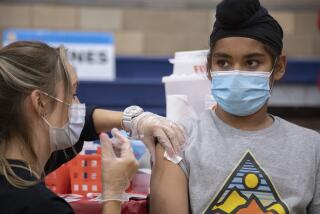COVID-19 vaccines prioritized for California educators will focus on struggling communities

- Share via
SACRAMENTO — California public health officials offered details Thursday on the new statewide COVID-19 vaccination effort for K-12 employees, with the priority being teachers and employees already working on-site at schools and those who serve students in disadvantaged communities.
Beginning on Monday, the program sets in motion Gov. Gavin Newsom’s promise last week to earmark 10% of California’s weekly allotment of vaccine doses for educators, possibly encouraging more schools to resume in-person instruction. Newsom and state legislators continue to negotiate the details of a far-reaching plan to reopen elementary school campuses, though disagreements remain over several issues — including how many schools could reopen in communities in the purple tier of the state’s coronavirus restrictions, where the number of COVID-19 cases is higher than a rate of seven positive cases for every 100,000 residents.
“The education professionals who nurture and support our children deserve to be and have been prioritized for vaccines, and I am proud to accelerate those efforts in all 58 counties,” Newsom said in a written statement.
Guidelines released Thursday show the 10% allotment will be reserved for K-12 school employees and those who work in childcare positions. Contrary to information provided last week, Newsom’s new effort is not aimed at speeding up vaccinations for higher education employees, though they remain eligible under last month’s expansion of the state’s general vaccination tiers. At least 35 counties have already begun vaccinating educators.
Newsom’s plan would expand those efforts to all 58 counties. His directive to set aside 10% of the state’s weekly vaccine allotment translates into at least 75,000 doses for educators. The most recent state data show about 319,000 public school teachers in California, with about 45% working in elementary schools. Educators at charter and private schools will also be given priority for vaccine appointments, along with school employees such as instructional assistants, bus drivers and food service workers.
Under the new program, state officials will use county offices of education to distribute vaccination appointments each week, based on the number of K-12 employees in a county and factors including the number of students from low-income families, those who are English language learners and foster youth. From there, the local education offices will make allocations to school districts, charter and private schools.
Newsom administration officials said the plan will complement, not contradict, efforts already underway in some communities. On Wednesday, the L.A. County Office of Education said 40% of its vaccination slots would be reserved for employees of the L.A. Unified School District.
Educators will be given a unique access code to register online for a COVID-19 vaccine appointment. While the state’s use of special codes has come under intense scrutiny — codes intended for communities hardest hit by the virus were wrongly shared among affluent residents in Southern California and the Bay Area — the school vaccine codes will only work one time and for a single appointment.
Among the educators who qualify, an additional priority will be given to those who are already working on-site or scheduled to do so within 21 days. A document provided by state officials said the 21-day window could change if additional vaccine doses become available and if more flexibility will “accelerate school reopenings.”
Newsom has faced considerable public pressure to accelerate the return to in-person learning as pandemic conditions improve across California. While he had long insisted his administration had already given a preference to vaccinate educators, his announcement last week served as a reminder that previous efforts had done little to quell criticism.
Data released by state officials earlier this month show fewer than half of California’s school districts had some amount of in-person instruction, with schools even a few miles apart in some communities making different choices about whether to bring students back to campus.
More to Read
Sign up for Essential California
The most important California stories and recommendations in your inbox every morning.
You may occasionally receive promotional content from the Los Angeles Times.














